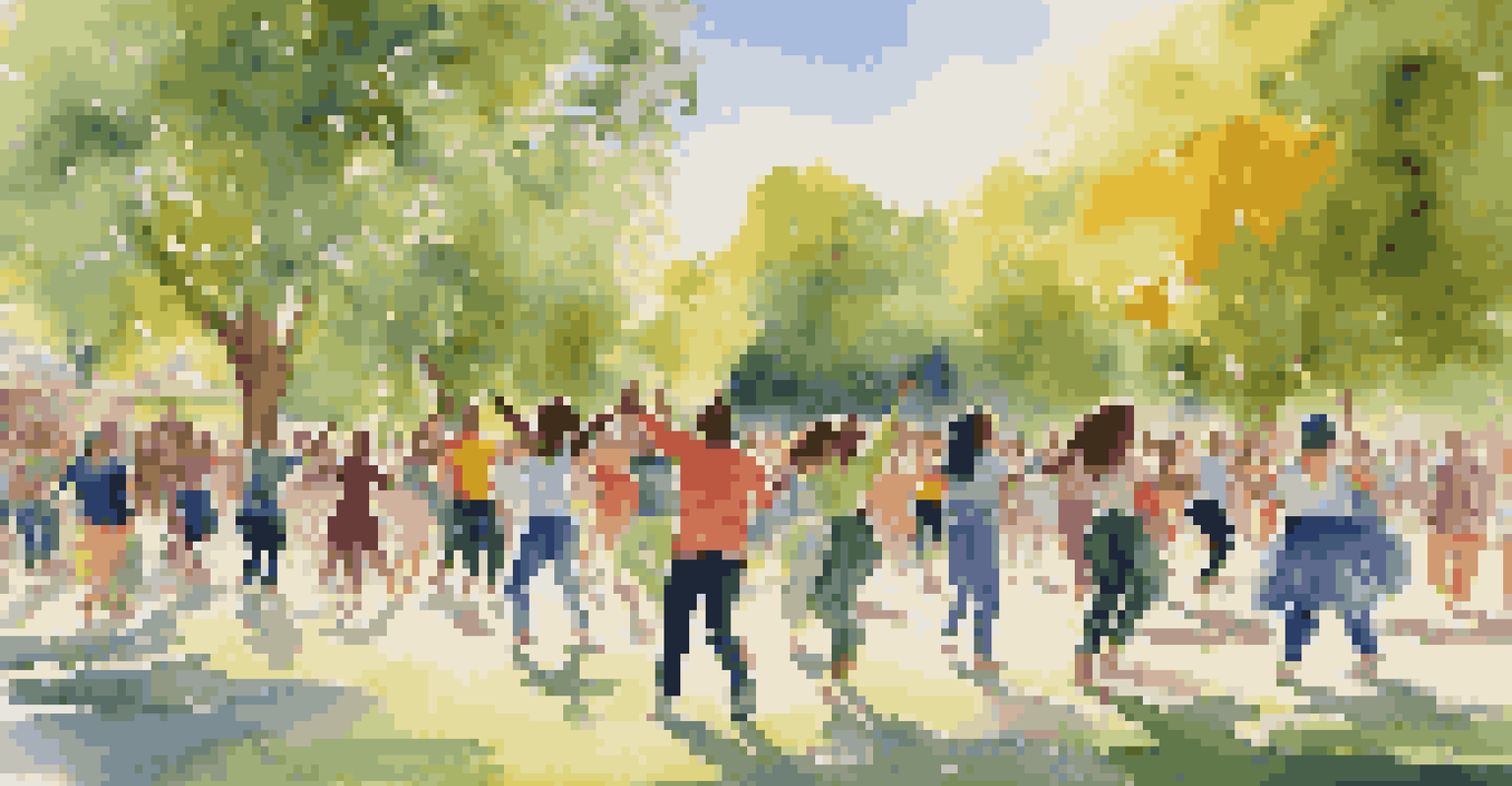Music and Movement: A Healing Connection for Mental Wellness

Understanding the Healing Power of Music
Music has a unique ability to evoke emotions and memories, making it a powerful tool for healing. It can uplift our spirits during tough times or help us relax after a long day. Research shows that listening to music can reduce stress and anxiety, providing a comforting escape from reality.
Music can change the world because it can change people.
Imagine a favorite song playing in the background while you unwind; the melody wraps around you like a warm hug. This emotional connection is why music therapy is increasingly recognized as a legitimate form of treatment. It’s not just about listening; it’s about feeling and processing emotions through sound.
Moreover, music can also enhance cognitive functions. Engaging with music stimulates brain activity, which can help with memory retention and focus. This is especially beneficial for individuals experiencing mental health challenges, as it creates a pathway for expression and healing.
Movement as a Form of Expression and Release
Movement, whether through dance, yoga, or simple stretching, serves as a physical outlet for our emotions. When we move our bodies, we release endorphins, which are natural mood lifters. Just think about how dancing to your favorite song can instantly brighten your day!

Incorporating movement into our daily routine can also alleviate symptoms of anxiety and depression. Activities like dance not only promote physical health but also foster a sense of community and belonging, which is vital for mental wellness. Moving together with others creates bonds that enhance our emotional well-being.
Music as a Healing Tool
Music can evoke emotions and memories, making it an effective method for reducing stress and enhancing mental well-being.
Additionally, movement can help ground us in the present moment. When we focus on the rhythm of our bodies and the music that guides us, we momentarily push aside worries and stressors. This mindfulness practice is essential for maintaining mental clarity and emotional balance.
The Science Behind Music and Movement Therapy
Numerous studies underline the effectiveness of music and movement therapy in promoting mental health. For instance, research has shown that these therapies can significantly reduce symptoms of PTSD, anxiety, and depression. The combination of rhythmic movement and music creates a holistic approach to healing.
Dance is the hidden language of the soul.
In therapy settings, professionals often use specific music genres to evoke certain emotions and encourage movement. This tailored approach allows individuals to explore their feelings and experiences through a creative lens. It’s fascinating how something as simple as a tune can unlock complex emotional responses.
The body responds to music and movement in profound ways, activating areas of the brain associated with emotion, memory, and even physical coordination. This interconnectedness highlights why integrating both elements into wellness programs can lead to more significant healing outcomes.
Creating Your Personalized Music and Movement Routine
To harness the healing power of music and movement, start by creating a routine that resonates with you. Choose songs that make you feel good and incorporate them into your daily activities. Whether it’s a morning stretch to your favorite playlist or a dance break in the afternoon, let the rhythm guide you.
Consider exploring different styles of movement that inspire joy and connection. This could be anything from Zumba classes to calming yoga sessions. The key is to find what feels right for you; the more you enjoy it, the more likely you are to stick with it.
Movement Boosts Emotional Health
Engaging in physical activities like dance or yoga releases endorphins, promoting mood improvement and community connection.
Don’t forget to vary your playlist to keep things fresh and exciting! Experiment with different genres—try classical for relaxation or upbeat pop for energizing workouts. This variety will not only keep you engaged but also enhance the overall healing experience.
Mindful Listening: A Key to Mental Clarity
Mindful listening involves fully immersing yourself in the music, paying attention to the lyrics, melodies, and rhythms. This practice can help you process emotions and clear mental clutter. By focusing intently on the sound, you create a moment of peace amid the chaos of daily life.
Engaging in mindful listening can also improve your concentration and awareness. As you tune into the details of a song, you train your brain to be present, which is crucial for mental wellness. It's similar to meditation, where the goal is to focus your mind and cultivate awareness.
You can enhance this experience by creating a cozy environment—dim the lights, close your eyes, and let the music wash over you. This simple act can provide a much-needed reset, helping you return to your day with renewed energy and clarity.
The Role of Community in Music and Movement
Participating in group music and movement activities fosters a sense of community and belonging. Whether you join a dance class or a local choir, these shared experiences can significantly boost your mood and overall mental health. The connections formed in these settings can be incredibly uplifting.
Community-based activities also provide support and encouragement. When you see others enjoying themselves, it inspires you to let go and embrace the moment. This collective joy can help combat feelings of isolation, a common challenge for many dealing with mental health issues.
Community Enhances Healing
Participating in group music and movement activities fosters a sense of belonging, which can significantly uplift mental health.
Furthermore, group activities often create a safe space for expression and vulnerability. Sharing the experience of music and movement allows individuals to connect on deeper levels, fostering empathy and understanding among participants. This sense of togetherness can be a powerful healing tool.
Embracing the Journey of Healing Through Music and Movement
Healing through music and movement is a journey, not a destination. It requires patience, practice, and a willingness to explore your emotions. Embrace the ups and downs, and remember that every step you take is part of the healing process.
Allow yourself to be open to new experiences and forms of expression. Whether it’s trying a new genre of music or a different style of dance, these explorations can lead to profound self-discovery. Celebrate the small victories along the way, as they contribute to your overall mental wellness.

Ultimately, the goal is to create a harmonious balance between your mind and body. By integrating music and movement into your life, you cultivate a nurturing environment for healing. So turn up the volume, move your body, and let the healing begin!